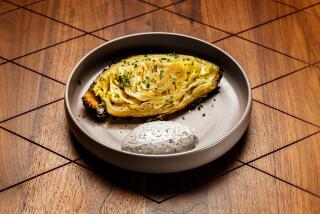Clambake
- Share via
No pit to dig, no bonfire to build--this clambake is prepared in a steamer on top of the back yard barbecue. It’s a California-style variation of the traditional meal, using fresh herbs, baby potatoes and West Coast seafood that’s in season.
Clambakes are delightful traditions to New Englanders. The most authentic ones are held on the beach, in pits dug and lined with smooth, round rocks. A fire is built on top of the rocks and kept burning two to three hours while seaweed is gathered and washed.
When the rocks are good and hot, embers are raked away and the pit is lined with several inches of seaweed. Then the traditional foods are added in layers--chicken, potatoes, corn, lobsters and clams. A tarp is placed over the top and held down with rocks while the food steams to perfection.
When there’s no access to a beach, people dig the pits in back yards. If seaweed is unavailable, mixed greens are substituted. Truthfully, these meals take a good deal of effort, no doubt the reason they are not as popular here on the West Coast.
There is a simpler method of preparing clambakes offered by seafood stores in that area of the country. They rent large steamers that cook the food over a wood or charcoal fire. The traditional ingredients are layered in an upper chamber with holes in the bottom, then it’s placed over the lower unit containing steaming water. A spigot near the bottom allows the water to be siphoned off during cooking, so it can be poured over the food to drain back into the lower chamber and become clam broth.
We used a smaller version of these commercial steamers on top of a back yard barbecue to cook our California-style clambake. For local sources of the 19-quart, two-part vessel manufactured by General Housewares Corp., please see today’s Kitchen Cabinet column on Page 24.
A 16-quart tamale steamer (available at Boy’s Markets and selected Lucky Stores) makes a good substitute for the clam steamer. It’s also possible to use lobster pots (sold at Ralphs Markets) or any other type of large stockpot for cooking a clambake. These do not have a spigot, so omit the directions for siphoning the water and pouring it over the food. Instead, just add water as needed during the cooking period. A 19-quart vessel accommodates a clambake serving four to six people.
With a couple days notice, some local seafood stores can supply seaweed for lining the bottom of the pot. Please see the related article on Page 2 for a list of seafood stores as well as information on ordering complete clambake packages.
This time of year, only live Maine lobsters are available, but if you prepare a clambake between October and March, keep in mind that Pacific lobsters are in season. Hold them on ice until time to add to the steamer.
Some West Coast native littleneck clams are currently available, but if you can’t find them, any other variety may be used. The same goes for crab--use Dungeness or whatever is available. Also, if the only crab obtainable is already cooked, just add it for the last few minutes of steaming to heat through.
Our chicken was cooked in the steamer, but it may also be grilled separately. Traditionally, baked or sweet potatoes are part of the bake, but we substituted baby red potatoes, which cook faster. We also speeded up cooking the corn by removing the husks and cutting the ears into 2-inch pieces. Pearl onions, fresh herbs and thick lemon slices were added to enhance flavor.
Complete the feast with lots of melted butter for dipping the seafood, crusty sourdough or French bread, ice cold beer and soft drinks and watermelon or other fresh fruit.
CALIFORNIA CLAMBAKE
2 to 3 pounds seaweed
4 chicken quarters
Paprika
2 to 3 lemons, thickly sliced
Tarragon sprigs
16 to 20 baby red potatoes
12 boiling onions
4 ears corn
3 dozen clams
Thyme sprigs
2 live lobsters
2 cooked Dungeness crabs
Melted butter
Lemon wedges
Place seaweed in large container and rinse several times with fresh water. Drain, cover again with water and set aside. Pour about 2 quarts water in bottom chamber of steamer and place on grill about 4-inches above hot charcoal. Cover with lid and bring to boil.
Meanwhile, sprinkle chicken with paprika. Wrap each quarter in cheesecloth and tie with string. When bottom part of cooker begins to steam, replenish charcoal. Drain seaweed and place 2 to 3-inches in bottom of upper chamber. Add chicken, lemon slices and tarragon sprigs. Place over bottom chamber, cover with lid and steam 30 minutes.
Scrub potatoes. Peel onions. Husk corn and cut ears into 2-inch pieces. Scrub clams and place 9 in each of 4 steamer bags.
Add potatoes, onions and thyme sprigs to steamer. Siphon water from bottom chamber and pour over food in steamer. Cook 20 minutes.
Rinse lobsters with fresh water. Add corn and lobsters to steamer. Check amount of water in bottom chamber and add more if necessary. Siphon water from bottom chamber and pour over food in steamer. Cook 10 minutes.
Add clams and crabs to steamer. Siphon water from bottom chamber and pour over food. Cook 10 minutes or until clams open.
Remove food from steamer and serve with melted butter and lemon wedges. Makes 4 servings.
Food Styling by Minnie Bernardino and Donna Deane.


